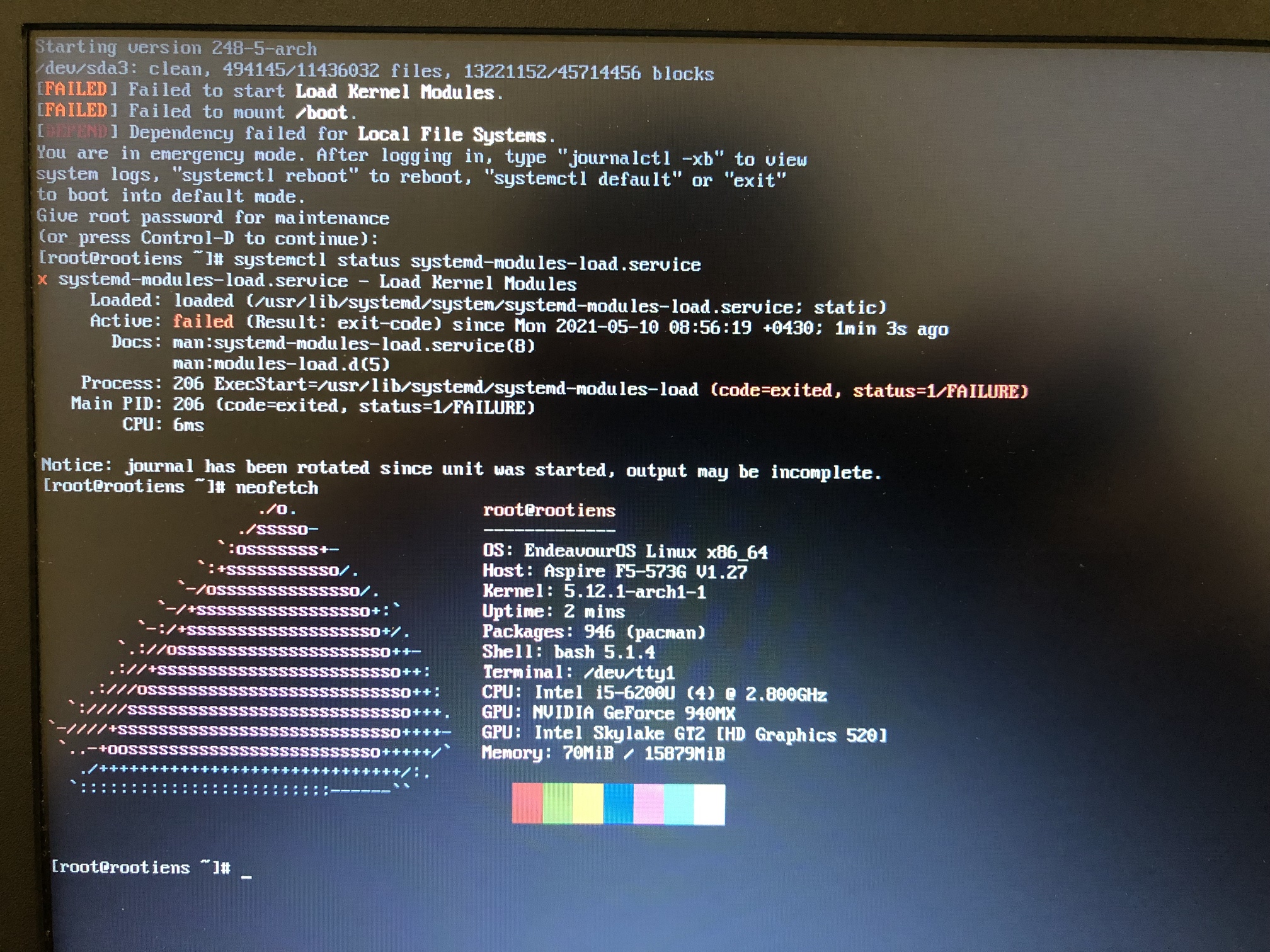Hi, i just updated my system with sudo pacman -Syu And after reboot i got this:

Idk if this helps or not, but i’m using legacy and mbr
Hi, i just updated my system with sudo pacman -Syu And after reboot i got this:

Idk if this helps or not, but i’m using legacy and mbr
Looks to me that it could not mount the /boot partition.
Is this your first reboot after install?
Do you have an USB stick connected still?
Are you sure your HDD / SDD is healthy?
no it’s not first reboot, i’ve installed it ~3 days ago and now it happened after updating my system
yes my SSD is fine, i can boot into windows and everything is normal
My suggestion then would be to boot on the Endeavour install stick and repair the bootloader:
https://sangams.com.np/how-to-restore-reinstall-grub-bootloader-in-arch-linux/
I guess you could try chrooting to your installation from the live ISO, making sure your boot partition is mounted as well and then reinstall your kernels. Reinstall the bootloader as mentioned above for good measure. Please have a look at how-to chroot into your system here:
luckily i had arch livecd, im reinstalling grub and kernel through chroot and let you know the result
Reinstalled grub and made config, but in only recognizes windows10 on sda2 O_o
(My linux installed on sda3)
What about the kernels?
From your live ISO, please post the output of
sudo parted -l
efibootmgr -v
Make sure you have internet connection in your Live environment. Chroot int your system according to the instructions in the aforementioned link.
cat /etc/fstab
Update your system:
yay
Then run:
sudo mkinitcpio -P
Update Grub:
sudo grub-mkconfig -o /boot/grub/grub.cfg
You could login to your forum account from the live iso and post the outputs of the commands above.
kernel is fine(i guess?), its just bootloader problem now
parted -l
[root@archiso /]# parted -l
Model: ATA KINGSTON SUV400S (scsi)
Disk /dev/sda: 240GB
Sector size (logical/physical): 512B/512B
Partition Table: msdos
Disk Flags:
Number Start End Size Type File system Flags
1 1049kB 608MB 607MB primary ntfs boot
2 608MB 52.8GB 52.2GB primary ntfs
3 52.8GB 240GB 187GB primary ext4
Model: USB3.0 FLASH DRIVE (scsi)
Disk /dev/sdb: 31.1GB
Sector size (logical/physical): 512B/512B
Partition Table: msdos
Disk Flags:
Number Start End Size Type File system Flags
1 1049kB 31.1GB 31.1GB primary fat32 boot, lba
efibootmgr -v (im usin legacy/mbr so i dont think its helpful)
[root@archiso /]# efibootmgr -v
EFI variables are not supported on this system.
cat /etc/fstab
[root@archiso /]# cat /etc/fstab
# /etc/fstab: static file system information.
#
# Use 'blkid' to print the universally unique identifier for a device; this may
# be used with UUID= as a more robust way to name devices that works even if
# disks are added and removed. See fstab(5).
#
# <file system> <mount point> <type> <options> <dump> <pass>
#UUID=4CD8CF1DD8CF03E4 /boot ntfs defaults,noatime 0 2
UUID=5e63c1a9-6a70-47cf-9ba1-178376d28230 / ext4 defaults,noatime 0 1
tmpfs /tmp tmpfs defaults,noatime,mode=1777 0 0
mkinitcpio -P
[root@archiso /]# mkinitcpio -P
==> Building image from preset: /etc/mkinitcpio.d/linux.preset: 'default'
-> -k /boot/vmlinuz-linux -c /etc/mkinitcpio.conf -g /boot/initramfs-linux.img
==> ERROR: specified kernel image does not exist: `/boot/vmlinuz-linux'
==> Building image from preset: /etc/mkinitcpio.d/linux.preset: 'fallback'
-> -k /boot/vmlinuz-linux -c /etc/mkinitcpio.conf -g /boot/initramfs-linux-fallback.img -S autodetect
==> ERROR: specified kernel image does not exist: `/boot/vmlinuz-linux'
[root@archiso /]#
grub-mkconfig
[root@archiso /]# sudo grub-mkconfig -o /boot/grub/grub.cfg
Generating grub configuration file ...
Found Windows 10 on /dev/sda1
Found Windows 10 on /dev/sda2
done
[root@archiso /]#
It doesn’t look so.
I think you would need to reinstall your kernel again from a chroot environment:
sudo pacman -Syu linux linux-headers
If you get the same errors as above, Look at linux.preset in /etc/mkinitcpio.d. It should have the following content:
# mkinitcpio preset file for the 'linux' package
ALL_config="/etc/mkinitcpio.conf"
ALL_kver="/boot/vmlinuz-linux"
PRESETS=('default' 'fallback')
#default_config="/etc/mkinitcpio.conf"
default_image="/boot/initramfs-linux.img"
#default_options=""
#fallback_config="/etc/mkinitcpio.conf"
fallback_image="/boot/initramfs-linux-fallback.img"
fallback_options="-S autodetect"
reinstalled as you said
this time :
[root@archiso mkinitcpio.d]# cat linux.preset
# mkinitcpio preset file for the 'linux' package
ALL_config="/etc/mkinitcpio.conf"
ALL_kver="/boot/vmlinuz-linux"
PRESETS=('default' 'fallback')
#default_config="/etc/mkinitcpio.conf"
default_image="/boot/initramfs-linux.img"
#default_options=""
#fallback_config="/etc/mkinitcpio.conf"
fallback_image="/boot/initramfs-linux-fallback.img"
fallback_options="-S autodetect"
after this , tried to make new config but still the same, no linux in grub
Could you run and post the output of:
sudo os-prober
from chroot.
?
And also please post the command line you have used for reinstalling the bootloader.
[root@archiso mkinitcpio.d]# os-prober
/dev/sda1:Windows 10:Windows:chain
/dev/sda2:Windows 10:Windows1:chain
installed grub and bootloader with arch wiki help
install grub package, then grub-install --target=i386-pc /dev/sda
and after that sudo grub-mkconfig -o /boot/grub/grub.cfg
Your commands look right to me. I am not sure what is lacking.
You didn’t get the errors as before after re-installing the kernel? ( as in the output of the mkinitcpio -P that you posted before).
What says:
ls /boot
?
no, i can do it again if u want
[root@archiso mkinitcpio.d]# ls /boot
grub grub.bak initramfs-linux-fallback.img initramfs-linux.img vmlinuz-linux
I don’t think you need to re-run it again. The images seem all to be in there. To be honest, I fail to see what might be lacking.
Do you mind waiting for other more advanced forumers to chime in and look at this with fresh eyes?
Can Windows see a Linux boot entry?
Boot into Windows and
You should get a list of all possible boot options including network boots etc. And of course any Linux ones.
thank you for you help, it meant much too me
also , i tried to create a custom entry in 40_custom but didnt work  so yea i will wait abit more.
so yea i will wait abit more.
and tbh, i can reinstall it again since i clean installed 3 days ago and havent done much customizing
Microsoft Windows [Version 10.0.19042.508]
(c) 2020 Microsoft Corporation. All rights reserved.
C:\Windows\system32>bcdedit.exe /enum firmware
Windows Boot Manager
--------------------
identifier {bootmgr}
device partition=E:
description Windows Boot Manager
locale en-US
inherit {globalsettings}
default {current}
resumeobject {4aa7e3be-af11-11eb-8ec7-8ef7591e632b}
displayorder {current}
{4aa7e3c2-af11-11eb-8ec7-8ef7591e632b}
toolsdisplayorder {memdiag}
timeout 30
a question, is it possible to remove grub completely and make an entry with EasyBCD since im usin mbr?